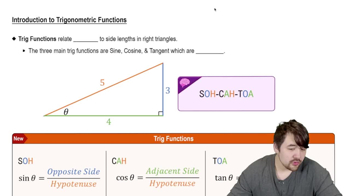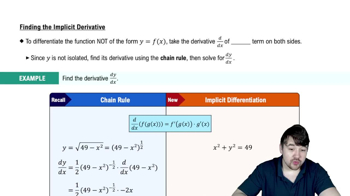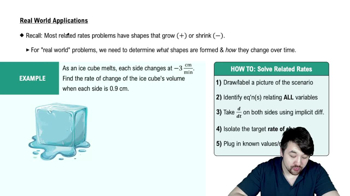Table of contents
- 0. Functions7h 52m
- Introduction to Functions16m
- Piecewise Functions10m
- Properties of Functions9m
- Common Functions1h 8m
- Transformations5m
- Combining Functions27m
- Exponent rules32m
- Exponential Functions28m
- Logarithmic Functions24m
- Properties of Logarithms34m
- Exponential & Logarithmic Equations35m
- Introduction to Trigonometric Functions38m
- Graphs of Trigonometric Functions44m
- Trigonometric Identities47m
- Inverse Trigonometric Functions48m
- 1. Limits and Continuity2h 2m
- 2. Intro to Derivatives1h 33m
- 3. Techniques of Differentiation3h 18m
- 4. Applications of Derivatives2h 38m
- 5. Graphical Applications of Derivatives6h 2m
- 6. Derivatives of Inverse, Exponential, & Logarithmic Functions2h 37m
- 7. Antiderivatives & Indefinite Integrals1h 26m
- 8. Definite Integrals4h 44m
- 9. Graphical Applications of Integrals2h 27m
- 10. Physics Applications of Integrals 2h 22m
4. Applications of Derivatives
Related Rates
Problem 3.11.47
Textbook Question
The bottom of a large theater screen is 3 ft above your eye level and the top of the screen is 10 ft above your eye level. Assume you walk away from the screen (perpendicular to the screen) at a rate of 3 ft/s while looking at the screen. What is the rate of change of the viewing angle θ when you are 30 ft from the wall on which the screen hangs, assuming the floor is horizontal (see figure)? <IMAGE>
 Verified step by step guidance
Verified step by step guidance1
First, understand the setup: You have a right triangle where the horizontal distance from the screen is the base, and the height of the screen forms the vertical side. The angle θ is the angle of elevation from your eye level to the top of the screen.
Define the variables: Let x be the distance from the screen, which changes over time. The height of the screen above your eye level is constant at 10 ft - 3 ft = 7 ft.
Use trigonometry to relate the angle θ to the distance x. The tangent of the angle θ is given by the ratio of the opposite side (height of the screen) to the adjacent side (distance from the screen): tan(θ) = 7/x.
Differentiate the equation tan(θ) = 7/x with respect to time t to find the rate of change of θ. Use implicit differentiation: d/dt [tan(θ)] = d/dt [7/x].
Apply the chain rule: sec²(θ) * (dθ/dt) = -7/x² * (dx/dt). Substitute dx/dt = 3 ft/s and x = 30 ft into the equation to solve for dθ/dt, the rate of change of the viewing angle.
 Verified video answer for a similar problem:
Verified video answer for a similar problem:This video solution was recommended by our tutors as helpful for the problem above
Video duration:
10mPlay a video:
Was this helpful?
Key Concepts
Here are the essential concepts you must grasp in order to answer the question correctly.
Related Rates
Related rates involve finding the rate at which one quantity changes in relation to another. In this problem, the viewing angle θ changes as the distance from the screen increases. By applying the concept of related rates, we can use derivatives to relate the rates of change of the distance from the screen and the angle of view.
Recommended video:

Intro To Related Rates
Trigonometric Functions
Trigonometric functions, particularly tangent, are essential for relating angles to opposite and adjacent sides in right triangles. In this scenario, the height of the screen and the distance from the viewer to the screen form a right triangle, allowing us to express the angle θ in terms of these dimensions using the tangent function.
Recommended video:

Introduction to Trigonometric Functions
Implicit Differentiation
Implicit differentiation is a technique used to differentiate equations that define one variable in terms of another without explicitly solving for one variable. In this problem, we can differentiate the relationship between the angle θ and the distance from the screen to find the rate of change of θ with respect to time, which is crucial for solving the problem.
Recommended video:

Finding The Implicit Derivative
Related Videos
Related Practice





